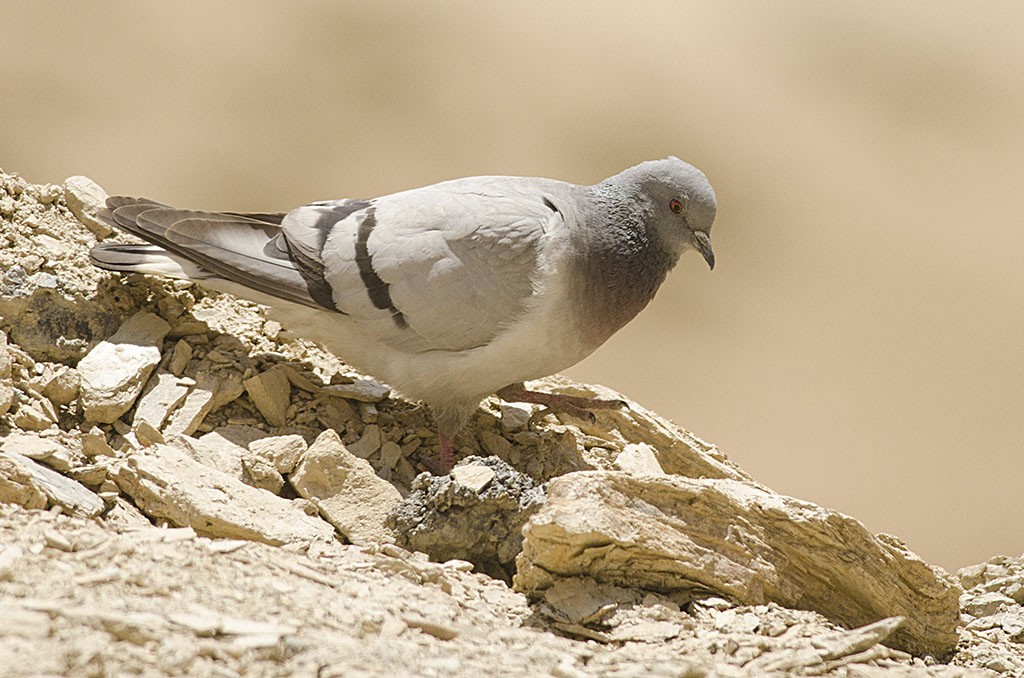Hill Pigeon
A species of Old World Pigeons Scientific name : Columba rupestris Genus : Old World Pigeons
Hill Pigeon, A species of Old World Pigeons
Botanical name: Columba rupestris
Genus: Old World Pigeons
Content
Description General Info
 Photo By As kannan , used under CC-BY-SA-4.0 /Cropped and compressed from original
Photo By As kannan , used under CC-BY-SA-4.0 /Cropped and compressed from original Description
The hill pigeon is a stout-bodied pigeon, similar in size and general appearance to the rock dove (also called the rock pigeon, but take note that members of the lesser known pigeon genus Petrophassa and the speckled pigeon (Columba guinea), also have the common name “rock pigeons”), but mainly differentiated by its tail pattern which consist of a broad, white tail-band across the black tail. Other differences include a paler mantle and upper wings and a white patch on the back. In flight, the tail pattern is similar to the snow pigeon, but lacks the contrast between the head and neck in that species. 
Size
35 cm
Nest Placement
Cliff
Feeding Habits
Hill Pigeon feeds mainly on seeds, grains, crop shoots, leaves, and some snails. Preferring to forage in small flocks, occasionally large, often near human habitation or with other Columba species. They are known to scavenge grain spills from mules or consume pilgrim-offered grains.
Habitat
The hill Pigeon inhabits open, rugged terrains typically characterized by cliffs and gorges. It is sociable, often forming flocks in its preferred rocky environments. In certain regions, the hill Pigeon adapts to urban areas, coexisting with and sometimes feeding alongside feral pigeons. While it migrates seasonally, the exclusion of elevation range specifics is maintained as requested.
Dite type
Granivorous
General Info
Feeding Habits
Bird food type
Behavior
This species frequents open rugged country from 1,500 to 6,100 m above sea level. They are closely related to rock doves, but more commonly are found at higher altitudes. A gregarious species throughout the year, they feed in flocks in the terraced, cultivated fields. They often mix with flocks of rock doves. They are very tame and are often found near human settlements, camps, and pilgrimage routes. In Tajikistan, it has been recorded as starting to nest as early as February, with many young just fledging as late as September in northeastern Tibet. The males have a bowing display similar to that of the rock dove and display and courtship is similar. They nest in dense colonies on cliffs, gorges, and rocky outcrops. In Tibet, the nests are often placed in houses, both inhabited and empty, or in holes in the wall. Nests consist of a platform of twigs or plant stems in which generally two eggs are laid. They may raise two brood in a year. Their feeding habits are similar to rock doves, being mainly granivorous, supplementing their diet with green shoot and leaves and occasionally small mollusks such as snails. On some occasions, they become very opportunistic, feeding on leftover food, partially digested food from kiang dung, and even undigested food from stomach of kiang carcasses which are ripped open by other predators. 
Distribution Area
It is found in China, Pakistan, India, Nepal, Kazakhstan, North Korea, South Korea, Mongolia, Russia, Tajikistan, Afghanistan, and Turkmenistan. This pigeon is comparatively restricted in range of Pakistan to the furthest northern inner valleys of the Karakoram, Hindu Kush, and Pamirs. In Pakistan, it occurs in northern Chitral, particularly in the western part bordering Nuristan in Afghanistan, further east in valleys of Gilgit in Yasin and Hunza and Karakoram ranges in Baltistan from about 2000 m in winter up to 5500 m during summer. Though the overall population is decreasing, the rate of decrease is not alarming and the bird is widely distributed and abundant; it is classified as least concern by the IUCN. 
Species Status
Not globally threatened.
Scientific Classification
Phylum
Chordates Class
Birds Order
Pigeons and doves Family
Dove Genus
Old World Pigeons Species
Hill Pigeon